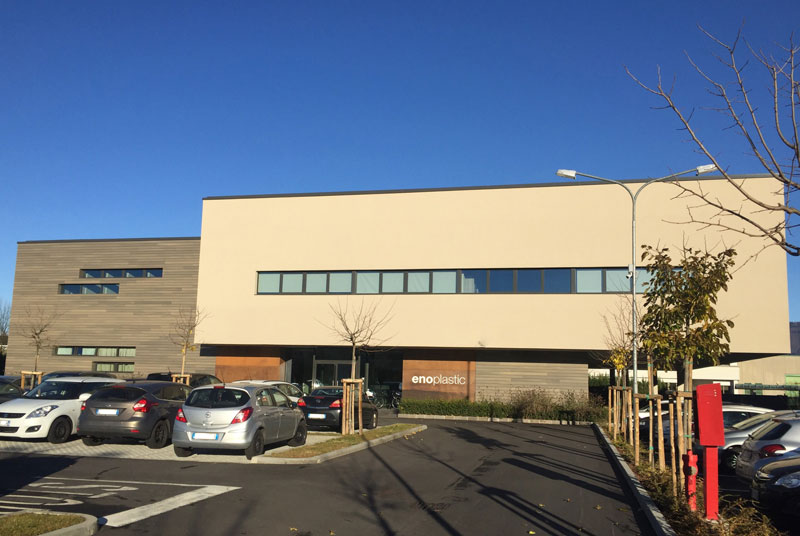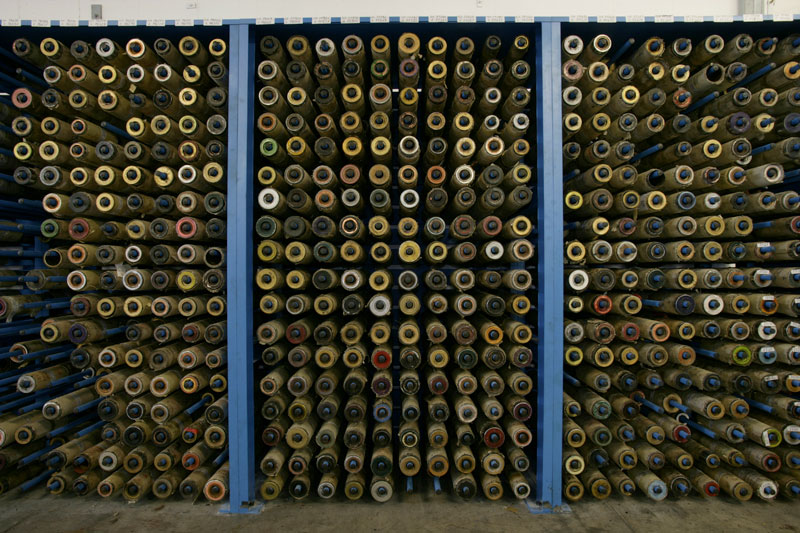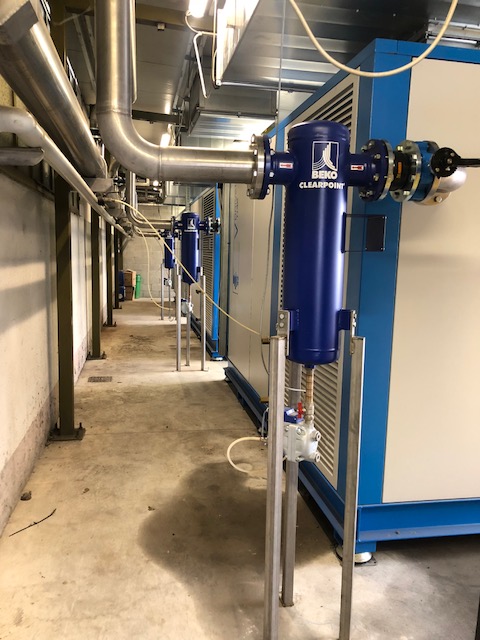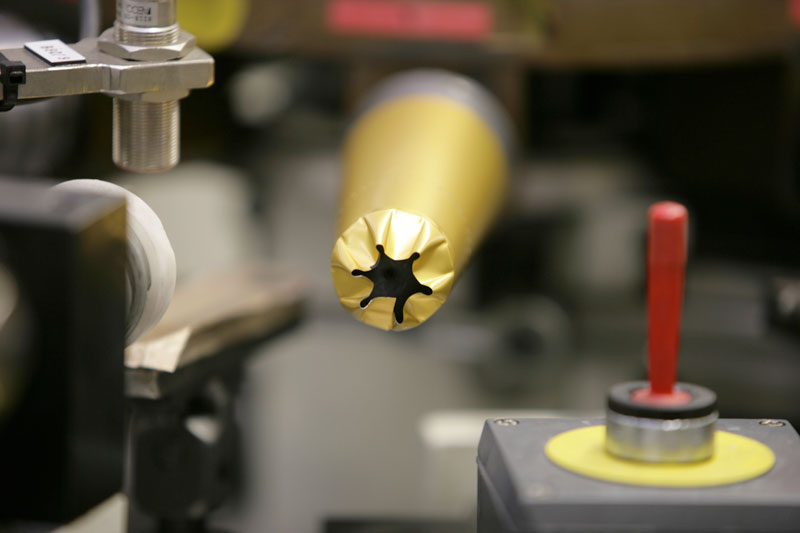News
Enoplastic relies on three V-Drive T from ALMiG
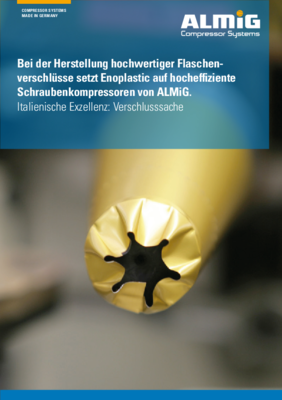
Piero Macchi loved good wine and industrial machinery - he brought these two passions together and founded a company in 1957 to manufacture closures and caps for wine, oil, vinegar and similar products. Today, Enoplastic S.p.a., based in Varese in north-west Lombardy, Italy, is one of the world's largest manufacturers of PVC and polylaminate capsules, screw caps, synthetic corks and seals for still and sparkling wines, spirits, olive oils and vinegars. In addition to Varese, the approximately 400 employees also work at sites in Spain, France, the USA, Australia and New Zealand. The group produces around 2.5 billion closures and labels a year and exports them to more than 60 countries.
"Our products epitomise Italian excellence and a high degree of creativity," explains the production manager at Enoplastic in Varese. "We offer creative and pioneering solutions, the necessary technical expertise and customised production with state-of-the-art machinery." This is because the demands of customers continue to increase and the market is becoming increasingly globalised. The production facilities include printing and gravure printing machines for up to eight colours, which give the products their unique character. Specially developed forming machines are also used to process the semi-finished products. The basis of the high-quality products are coils of aluminium and PVC, which are joined together in a special machine to form a multi-layer composite.
Nothing works without compressed air
"There's a lot of compressed air behind every cork and every screw cap," says the production manager at Enoplastic, pointing to one of the forming machines that draws a particularly large amount of this form of energy. Compressed air is an indispensable resource for Enoplastic, and ensuring the efficiency of the production plant is one of the maintenance priorities. The production of compressed air accounted for around 30 per cent of electricity consumption and the company wanted to take action to improve the situation.
The renovation of the main production hall was the perfect time to do so. The compressors that had been in use up to that point had clocked up almost 75,000 working hours. "Above all, we wanted to noticeably increase energy efficiency with new systems and reduce overall electricity consumption by around 15 per cent," says the Production Manager, explaining the goals. "We also wanted to significantly reduce CO2 emissions." The managers looked around the market. One supplier immediately stood out for them: Enoplastic had been using a DIRECT 45 series screw compressor from ALMiG in another factory building for around seven years - and had had very good experience with this machine.
An external energy consultancy firm had installed an analysis system in the production area. This made it possible to measure both compressed air consumption and electricity consumption. This software can be used to analyse the results and create various simulations. Compressors are specifically replaced for this purpose. "We simulate and compare in order to achieve the optimum energy result for the customer," explains Roberto Spezzibottiani from ALMiG Italia. The measurements are carried out both at times of low capacity utilisation and at full capacity. After detailed analyses, the expert recommended three air-cooled and speed-controlled screw compressors from the V-Drive T series with heat recovery. The volume flow is 65 cubic metres per minute - measured from 6 a.m. to 10 p.m. - and 32 cubic metres per minute at night. The system can provide up to 81 cubic metres of compressed air per hour. The compressors impressed those responsible with their combined efficient two-stage compression with speed control, among other things.
Compressors of the latest generation
Thanks to the gear drive, the two compressor stages achieve the optimum transmission ratio. An oil mist for intercooling ensures efficient compression. The oil also prevents the pressure from falling below the dew point. "This rules out condensate failure in the second compressor stage," says Roberto Spezzibottiani.
The V-Drive T compressors automatically and sensitively adjust the delivery volumes to the fluctuating air consumption - this is ensured by the speed control and the varying motor speed. This reduces costly and energy-intensive idle time. "The low speeds and lower internal stage pressure difference increase the efficiency of the systems," explains Spezzibottiani. "They are in use for longer and allow the compressor unit to work even more reliably." With several thousand load changes per year, the energy consumption can add up considerably. Compared to compressors that are regulated in load-idle mode, the ALMiG devices also save a significant amount of energy.
The average delivery rate of the compressors is 65 cubic metres per minute during the day and around 32 m3/min at night. The line pressure is 6.8 bar and is infinitely adjustable. To ensure high availability, all three compressors are always on standby. During base load changes, the systems start up one after the other. One then serves as a backup in case a compressor needs to be serviced or repaired. Enoplastic can also react reliably to peak times and is equipped for further growth in the coming years.
Reliably controlled
The ALMiG Air Control HE controls the compressors that are currently in use, depending on consumption. This allows the operator to fully utilise the energy benefits of speed control, as the systems only generate as much compressed air as they actually consume. The pressure remains constant. "If consumption rises towards the maximum delivery volume of a system, the second compressor switches on. A speed reserve is maintained so that no pressure fluctuations occur when the compressors are switched on and off and the station runs economically," explains Roberto Spezzibottiani. In the main load phase, i.e. during peak production times, two systems run synchronised at the same speed. In the off-peak phase, when production is lower, only one compressor runs. This automatically adapts to the consumption profile. As the machines are in the medium speed range, both energy consumption and noise emissions are lower.
In addition, the machine components are subjected to less stress, which has a positive effect on the service life of the compressors. "Our premium control units are equipped with a balance monitoring system as standard, as well as a web server," Spezzibottiani continues. This makes it possible to read out all relevant data via the internet.
Service technicians can read off the running behaviour of the last few days or weeks of operation via remote maintenance and see how heavily the compressor is being used, when maintenance is due and whether there are still reserves available. "If we notice that the operating behaviour has changed significantly, the responsible employees can react immediately," says Spezzibottiani.
It is important that the compressed air is dry. It is treated with a refrigeration dryer, pre- and after-filter. All devices are also equipped with automatic condensate drains, which are connected to an oil separation system via activated carbon filters. "One advantage is that the external refrigeration dryers are thermally separated from the hot zone of the compressor," says Roberto Spezzibottiani. "This means there is no so-called refrigerator in the oven."
Saving heating costs with heat recovery
One of the objectives was to integrate the heat recovered from the compressors into the heating system and heat the new building completely during the winter months. To this end, the machines are factory-fitted with heat exchangers and water control valves for heating water to 70°C. The oil that cools the compressors heats the water in a heat exchanger and is fed directly into the heating system. This results in a high potential saving in heating costs, especially in winter - estimated at 17,000 euros per year.
After eight months in operation, which corresponds to around 3,000 working hours, the compressors are running extremely reliably. There have been no breakdowns in all this time. The expected total savings are around 75,000 euros per year. "The return on investment of the entire compressed air station is expected to be achieved in 3.5 years," calculated Enoplastic. The efficiency of the system is currently around 0.095 kilowatt hours per cubic metre.
The V-Drive T screw compressors are also easy to maintain and only require servicing every 4,000 operating hours: all components are easily accessible from one side and the large sound-insulating doors can be easily removed. This significantly reduces maintenance and downtimes. This also keeps service costs manageable.
Enoplastic's management is convinced that the decision to continue working with ALMiG was the right one.
Those responsible at Enoplastic were impressed by the excellent advice given in advance and the expertise of the ALMiG employees. The installation was realised in detail just as ALMiG had planned. "The project took about a year from the initial contact to the commissioning of the last machine," says the production manager.
An external energy consulting firm had installed an analysis system in the production facility. This made it possible to measure both compressed air consumption and electricity consumption. This software can be used to analyze the results and create various simulations. Compressors are specifically replaced for this purpose. "We simulate and compare in order to achieve the optimum energy result for the customer," explains Roberto Spezzibottiani from ALMiG Italia. The measurements are carried out both at times of low capacity utilization and at full capacity. After a detailed analysis, the expert recommended three air-cooled and speed-controlled screw compressors from the V-Drive T series with heat recovery. The volume flow is 65 cubic meters per minute - measured from 6 a.m. to 10 p.m. - and 32 cubic meters per minute at night. The system can provide up to 81 cubic meters of compressed air per hour. The compressors impressed those responsible with their combined efficient two-stage compression with speed control, among other things.
Compressors of the latest generation
Thanks to the gear drive, the two compressor stages achieve the optimum transmission ratio. An oil mist for intercooling ensures efficient compression. The oil also prevents the pressure from falling below the dew point. "This rules out condensate failure in the second compressor stage," says Roberto Spezzibottiani.
The V-Drive T compressors automatically and sensitively adjust the delivery volumes to the fluctuating air consumption - this is ensured by the speed control and the varying motor speed. This reduces costly and energy-intensive idle time. "The low speeds and lower internal stage pressure difference increase the efficiency of the systems," explains Spezzibottiani. "They are in use for longer and allow the compressor unit to work even more reliably." With several thousand load changes per year, the energy consumption can add up considerably. Compared to compressors that are regulated in load-idle mode, the ALMiG devices also save a significant amount of energy.


